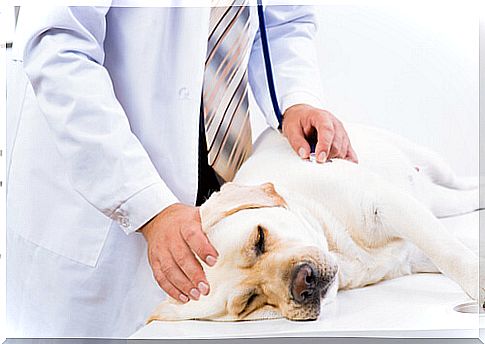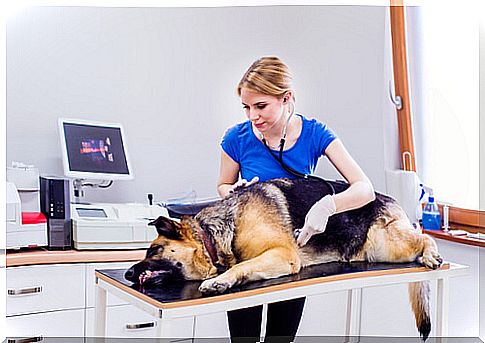Liver Problems In Dogs

Liver problems in dogs are difficult to detect. In addition, they occasionally appear as a secondary disease. This means that the dog can suffer from a disease that affects the liver in a secondary way, which is normally reflected in the biochemical analyzes of the blood.
The liver has many functions related to the metabolism of certain nutrients, such as proteins, carbohydrates, and fats. It is also related to the metabolism of vitamins and minerals.
Another irreplaceable function of the liver is its capacity for the elimination and excretion of toxins and drugs, carried by the blood, as well as the function of forming and eliminating bile.
Symptoms of liver problems in dogs
When a liver begins to lose its functional capacity, a series of symptoms appear. They do not have to appear all and, sometimes, they can be confused with symptoms of another disease. Symptoms that dogs with liver disease can develop are:
- Apathy. The dog can be tired, lacking in vitality and wanting to move.
- Loss of appetite. We can notice that the dog has little desire to eat or, at least, not as much as usual.
- Dehydration Even if you drink water as you normally do, as your liver does not function properly, water does not hydrate the cells of the body. We can see if a dog is not hydrated if we pinch a piece of the skin on the back and it takes time to return to its place.
- Change in the coloration of the mucous membranes. When there is a deficiency in the liver, the mucous membranes of the dog tend to turn yellow. This is known as jaundice.
- Weightloss. The dog can lose weight due to a lack of appetite, coupled with the incorrect metabolism of nutrients.
- Chronic or recurring vomiting. When the liver problem increases, other symptoms show up. This is the case of vomiting, which is usually yellow and frothy.
- Polydipsia and polyuria. These terms refer, respectively, to an increase in the amount of water ingested and urine excreted.
- Ascites It is the accumulation of fluid in the abdomen, produced by the decrease in serum proteins and increased venous tension.
- Diarrhea.
- Neurological signs. Due to the accumulation of toxins in the blood due to the lack of liver function, these can affect the brain, causing an inflammation of the brain.

Diseases that cause liver problems
When symptoms of liver disease appear, our first thought is that there could be a problem or deficiency in the function of this organ. However, when a liver problem is detected, through blood tests, we must rule out other possibilities.
Some of the pathologies or diseases that can cause liver damage are:
- Intoxications. During a routine walk, our dog is exposed, unfortunately, to be intoxicated with multiple substances, some placed consciously and others not. If we visit urban parks or agricultural areas, the dog can be poisoned by herbicides, insecticides or fertilizers. In addition, it can ingest poisonous substances intended for other animals.
- Infectious hepatitis. This disease is caused by canine adenovirus type 1 (CAV-1). This virus is transmitted through the bodily fluids of sick animals, such as urine, feces, or saliva. It does not have a specific treatment, only life support and, on occasions, it can become chronic.
- Leptospirosis. The cause of leptospirosis is a bacterium that can be transmitted to humans, that is, it is a zoonotic disease. It is transmitted by being in contact with the fluids of animals or infected waters. In addition to the liver, it also affects the heart, kidneys and lungs.
- Filariasis. It is a nematode infection that can affect organs such as the heart, lungs, skin, or eyes. It is a zoonotic disease transmitted by insects and affects the liver in a secondary way.
- Cushing’s syndrome. Cushing’s disease is a hormonal decompensation that some dogs can suffer from. The adrenocortical glands begin to produce a hormone – cortisol – in excess, which can affect other organs such as the liver.
- Mellitus diabetes. This disease is characterized by causing the total or partial absence of insulin in the blood. Secondarily, it can increase the risk of developing inflammation or scarring of the liver.

How to prevent
When liver problems in dogs derive from other diseases, if that disease is cured, the liver is also healed. Each disease has its own preventive method. For example, cases such as filariasis or other diseases transmitted by insects, simply use repellants and avoid the areas where these insects live.
Occasionally, hormonal diseases such as diabetes or Cushing derive from a poor diet and, in many cases, cause obesity. Keeping our pet healthy, well fed and exercised is essential for the proper functioning of its body.
Lastly, liver failure, as well as kidney failure, sometimes occur in older dogs. It is true that age affects, but the correct diet is a priority. Do not forget that the liver belongs to the digestive system of the dog and can be affected by multiple factors.
It might interest you …
Main image source | http://www.clinicaveterinariasanjorge.com










